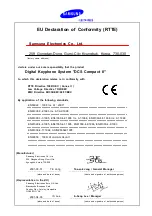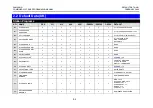
SAMSUNG
INTRODUCTION
COMBINED SYSTEMS PROGRAMMING MANUAL
FEBRUARY 2004
1–1
Part 1. Introduction to Programming
It is strongly recommended that you read the whole of this part of the manual as it pro-
vides a useful overview of MMC programming procedures.
1.1 Using this Manual
•
For a comprehensive list of available MMCs in numerical order, see
Part 2.
•
For quick reference, Part 2 also provides a
indicating which systems can use
each MMC. “Y” (Yes) in the appropriate column indicates that an MMC can be used
for that system. The table also lists default settings for each MMC (for the UK only).
•
To begin programming, refer to the appropriate MMC(s) in
. When you select
an MMC, check the header bar. This also tells you if the program is available on your
system.
•
To quickly check the allowed configuration settings for your system—for example, the
number of trunk group members, card port numbers, and so on—see
System Configuration: Quick Reference,
1.2 Systems Covered in this Manual
This manual describes the MMC programming required for the Samsung telephone sys-
tems listed in the following table. The table includes the name by which each system is
referred to in this manual (to avoid using the full name each time), and any other relevant
details.
Telephone System
Referred Name
Comment
DCS DCS
Unless otherwise stated, references to
“DCS” in this manual include Compact I
systems.
DCS Compact
Compact I (or CI)
See comment above.
DCS Compact II
Compact II (or CII)
DCS-816 816
DCS-408 408
DCS-408i 408i
i
DCS500 (L and M versions)
i
DCS500
i
DCS100
i
DCS100
Where programming requirements are
the same, the term “
i
DCS” is used in
this manual to include both
i
DCS100
and
i
DCS500 systems. The term
“
i
DCS500” includes both ‘L’ and ‘M’
versions, unless stated otherwise.
OfficeServ500 (L, M and S
versions)
OS500
The term “OS500” includes ‘L’, ‘M’ and
‘S’ versions, unless stated otherwise.












































